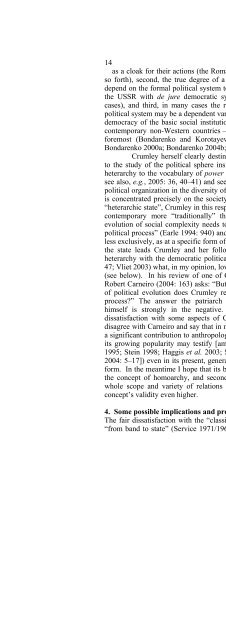Bondarenko Dmitri M. Homoarchy
Bondarenko Dmitri M. Homoarchy
Bondarenko Dmitri M. Homoarchy
Create successful ePaper yourself
Turn your PDF publications into a flip-book with our unique Google optimized e-Paper software.
14<br />
as a cloak for their actions (the Roman Senate in the time of Princepses and<br />
so forth), second, the true degree of a political system’s democracy does not<br />
depend on the formal political system too heavily (compare, e.g., the USA and<br />
the USSR with de jure democratic systems of political institutions in both<br />
cases), and third, in many cases the real democracy or non-democracy of a<br />
political system may be a dependent variable with respect to democracy or nondemocracy<br />
of the basic social institutions; in preindustrial societies and many<br />
contemporary non-Western countries – the family and community 3 first and<br />
foremost (<strong>Bondarenko</strong> and Korotayev 2000c; 2001; 2004; Korotayev and<br />
<strong>Bondarenko</strong> 2000a; <strong>Bondarenko</strong> 2004b; Barry 2003; 2004).<br />
Crumley herself clearly destines the notion of heterarchy exclusively<br />
to the study of the political sphere insisting just on “the addition of the term<br />
heterarchy to the vocabulary of power relations…” (1995: 3; emphasis added;<br />
see also, e.g., 2005: 36, 40–41) and sees the prerequisite for heterarchic sociopolitical<br />
organization in the diversity of sources of power, as far as her concept<br />
is concentrated precisely on the society’s political subsystem. 4 Discussing the<br />
“heterarchic state”, Crumley in this respect does not differ from the majority of<br />
contemporary more “traditionally” thinking theorists who “argue that the<br />
evolution of social complexity needs to be understood first and foremost as a<br />
political process” (Earle 1994: 940) and also tends to look at the state, more or<br />
less exclusively, as at a specific form of political organization. Such a glance at<br />
the state leads Crumley and her followers to unreasonable identification of<br />
heterarchy with the democratic political regime (Crumley 1995: 3; 2005: 46–<br />
47; Vliet 2003) what, in my opinion, lowers the euristic potential of her concept<br />
(see below). In his review of one of Crumley’s recent articles on heterarchy<br />
Robert Carneiro (2004: 163) asks: “But by introducing this term into the study<br />
of political evolution does Crumley really enhance our understanding of the<br />
process?” The answer the patriarch of cultural evolutionist studies gives<br />
himself is strongly in the negative. However, notwithstanding my own<br />
dissatisfaction with some aspects of Crumley’s approach, I would still dare<br />
disagree with Carneiro and say that in my opinion, the concept of heterarchy is<br />
a significant contribution to anthropological and archaeological theory (to what<br />
its growing popularity may testify [among others, see, e.g., Ehrenreich et al.<br />
1995; Stein 1998; Haggis et al. 2003; Scarborough et al. 2003; Alexeev et al.<br />
2004: 5–17]) even in its present, generally less process- than typology-shaped,<br />
form. In the meantime I hope that its broadening, first, by supplementing with<br />
the concept of homoarchy, and second, by extending its inclusion up to the<br />
whole scope and variety of relations in society, could make the heterarchy<br />
concept’s validity even higher.<br />
4. Some possible implications and prospects<br />
The fair dissatisfaction with the “classical” unilineal typological schemes like<br />
“from band to state” (Service 1971/1962) or “from egalitarian organization to







